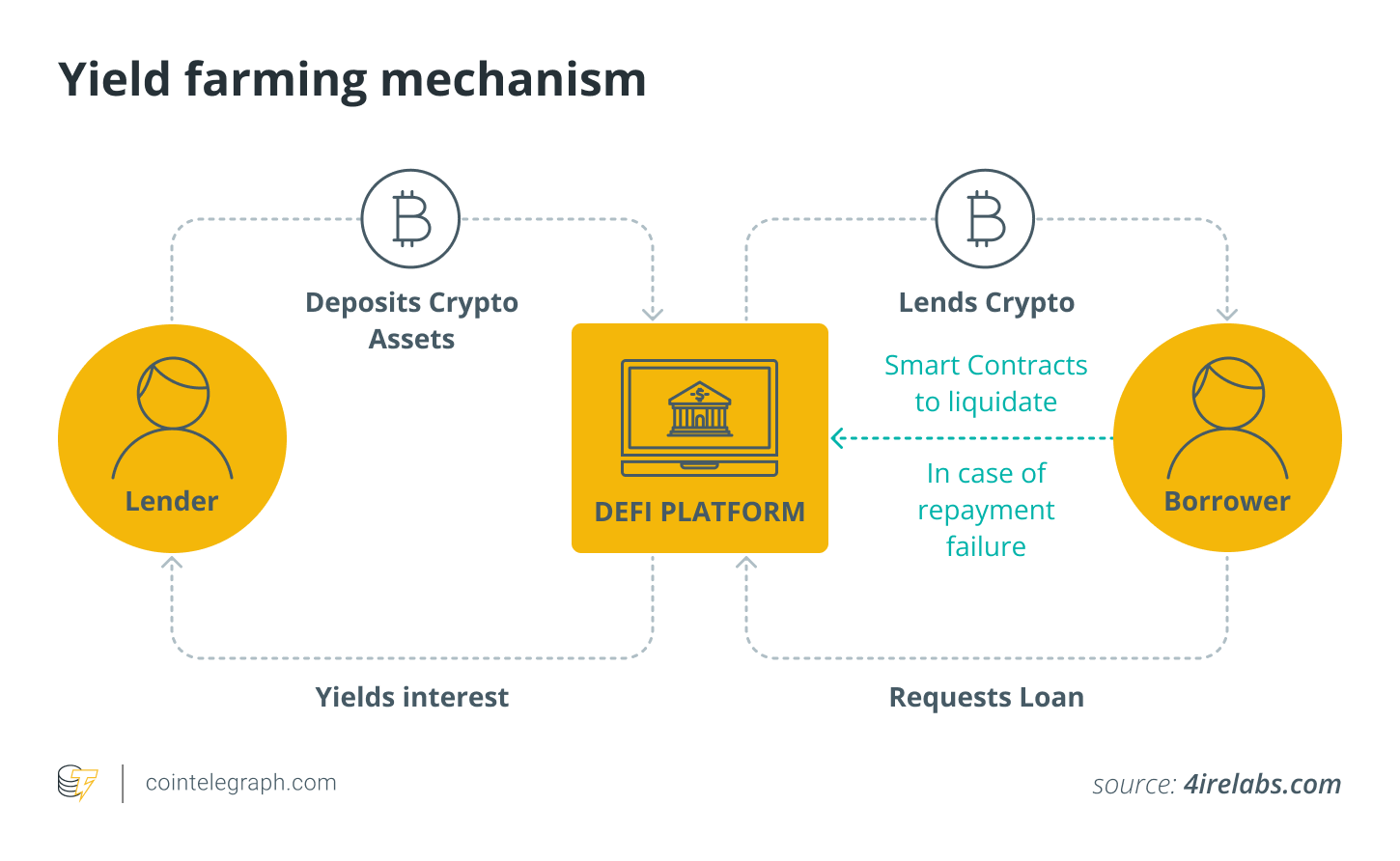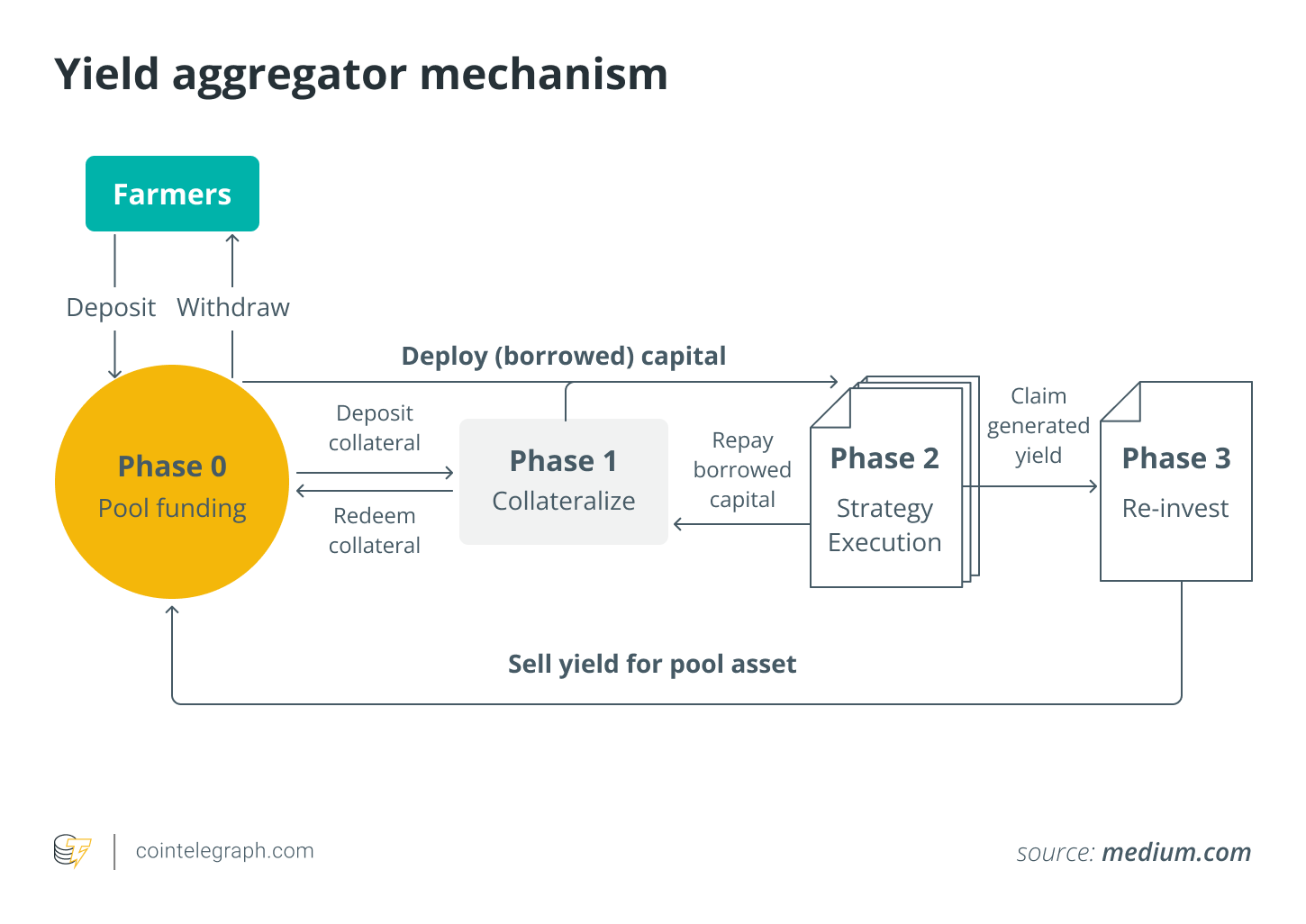One emerging and fast-growing financial technology branch of the cryptocurrency industry is decentralized finance (DeFi), based on distributed ledgers where transactions are verified and approved by the decentralized network without needing third parties like banks.
DeFi was developed to challenge the limits of the traditional financial system, identified as centralized finance (CeFi), which relies on intermediaries to function. In 2022, the total value locked (TVL) for DeFi reached nearly $2 billion globally, growing from $400 million in the previous two years. Apart from the permissionless and decentralized nature of DeFi, the main driver of the industry's growth has been its flexibility, with a plethora of platforms that combine services like an exchange, lending and yield farming to thrive in this network of economic forces.
This article will help users to understand the importance, rewards and risks of this new branch of DeFi known as yield aggregators. We start by getting familiar with the concept of yield farming.
Yield farming
Yield farming is one field of DeFi that allows crypto investors to earn rewards by moving their tokens to yield-generating smart contracts. In this process, the investor is the liquidity provider (LP), and the liquidity pool is a cash-filled smart contract. The automated market maker is another critical network component in yield farming that allows users to trade through an automated system via liquidity pools instead of the traditional buyer and seller market.

The concept started to rise in popularity with the creation of COMP, the governance token of the DeFi lending protocol Compound. Such a protocol rewards participant users with newly-minted COMP tokens when they use lending and borrowing services in a process called “liquidity mining.”
Other than being rewarded with interest when lending and fees when providing liquidity, yield farming participants started to be rewarded with governance tokens to increase their participation in the early adoption of the platform. Such various rewards in the form of interest, fees and token distribution created the foundation for DeFi yield aggregators.
What is a DeFi yield aggregator?
Yield aggregators, also called “auto-compounders” or “yield optimizers,” play a crucial role in the yield economy by combining different DeFi protocols (smart contracts) and strategies to maximize investors' profits.
Yield aggregators are a set of smart contracts that pool investors' crypto assets (tokens) and invest them in a portfolio of yield-paying products and services through pre-programmed and automatically executed strategies.
It's almost like having a fund manager take care of an investor's portfolio and provide the best DeFi crypto staking opportunities to obtain maximum profits. Various yield aggregators are available, and they are all similar except in the blockchain they support and the relevant DeFi smart contracts they utilize, so the difference is mainly technical. However, their fees and interest rates may differ, so crypto investors should examine their offerings before signing up.
How do yield aggregators work?
The yield farming process typically expects participants to lock up or stake their funds, and yield aggregators work by automating the farming process to produce the highest yields possible. Let's see how this system works in detail.
Real-life terms like “farm” are not used by chance. A farm is where crops are grown to generate a yield. The same concept applies to yield farming in DeFi, wherein “farmers” put their investment (crop) to generate profits (yields).
Yield aggregators combine the investments of various farmers (crypto investors) to facilitate profits earning using different strategies while remaining idle and waiting to accumulate passive income since the automated service provided by yield aggregators does it all for them.

Using these strategies, investors can move tokens around different platforms, optimizing yields via auto-compounding. This process allows stakers to claim and restake their rewards without the need to do it manually.
Some of the tokens used in yield farming are governance tokens that are essential to allow participants to influence management decisions by voting. Protocols issue governance tokens to incentivize the network's activity and to propose and vote on changes. Such incentives generate more fees, leading to higher deposited token yields.
Yield strategies
One popular yield strategy is to provide liquidity to a decentralized exchange (DEX). Liquidity is an essential component of DeFi, and DEXs replace the traditional order book with a liquidity pool where participants provide the crypto assets to be traded. This way, liquidity is good enough to enable instant trades, and LPs can receive a share of the transaction fee in return.
However, investors should typically claim these dividends manually and pay a gas fee every time, affecting their profits and lowering their staking annual percentage yield (APY). APY and annual percentage return (APR) are the leading indicators of earnings accrued in a year by depositing tokens on a platform. While APY includes the compounding interest of the asset, the APR does not.
They are variable indicators based on trade volume, which generates fees in a liquidity pool and on the TVL of the vault (smart contract) considered. More people participating in a vault means the APY will be lower since the rewarded tokens will be distributed more.
Transaction fees might not be reasonable enough incentives for LPs. Another strategy to get rewards in yield farming is depositing (staking) LP tokens into a farm that will pay participants the rewards in its native LP — or single — tokens.
In this case, yield aggregators enable users to automate this process and save on gas fees by staking their LP or single tokens in vaults. They will automatically claim them, convert them into interest-bearing assets and deposit them back into the farm for maximum profit.
The token's value rises thanks to the redistribution of accumulated vault fees and the sharing of earned vault rewards by staking the aggregator protocol's token. In contrast with farms, vaults auto-compound the deposit at specific intervals, for example, every five minutes. By auto-compounding, vaults automatically harvest rewards, which are then re-invested in the pool, so the yield is calculated over the new total amount.
By using yield aggregators, the process of staking, collecting and re-investing the generated profits on behalf of users is automated. Maximum profits are achieved by performing this process in batches and sharing gas fees among all participants, making such costs negligible.
Yield aggregator platforms
Technological innovation happens so fast in DeFi that it's challenging to keep up with all the new protocols and services available. However, competition between the different platforms allows a broader range of offers with higher interest rates and lower fees for investors.
Most DeFi yield aggregators are deployed on Ethereum, followed by Polygon. Investors should ensure the network chosen for yield optimization is compatible with the blockchain that hosts their assets.
Yearn.finance is one of the top yield aggregators, based on Ethereum and accessible through Fantom and Arbitrum. It's a versatile platform because it allows users to optimize the yield by combining liquidity pool staking, crypto lending, yield farming pools and the recently added Ethereum staking to produce the optimal APY rate for staking crypto assets.
Convex Finance is different from Yearn.finance as it only offers liquidity staking. However, Convex uses Curve (CRV) staking to give LPs on its platform access to yield boosts. CRV is an automated market maker, and by leveraging it, Convex LPs can earn trading fees and claim boosted CRV without the need to lock it.
Harvest Finance is an automated yield farming protocol that offers a yield with compounding interest through its farm liquidity mining program. It is easy for beginners and non-techie investors who want the highest passive income, as it automates the collection of capital from different yield farmers, saving money and time for participants.
Are DeFi yield aggregators risky?
Yield farming and aggregators exist primarily to allow crypto investors to earn rewards and increase their token holdings instead of having their assets dormant in a wallet while waiting for a rise in the token value.
However, alongside great potential rewards, yield strategies could carry some risks. Due to the system's composability, different protocol layers are involved in the yield process, facilitating the proliferation of threats like scams and bugs that could drive the token price to zero.
Impermanent loss and liquidation risks should be considered when deciding to venture into yield farming using yield aggregators because returns or assets might be lost if such events occur.
An impermanent loss could reduce returns when the prices of the underlying assets start to change. On the other hand, a liquidation risk occurs when investors borrow funds and the value of the collateral asset falls below a predetermined liquidation threshold.
These risks are aggravated for small investors if we consider that large-fund farmers have far greater control over the protocol and can manipulate an asset's price. Moreover, small investors could be less likely to repay a loan if the collateral's price falls below a certain level, being liquidated more easily than prominent investors.
To avoid these risks, users should adequately audit the platform they want to employ. Yield aggregator tools facilitate the passive income of crypto farmers, allowing them to go on with their lives while earning some potential returns. However, investors should keep an eye on the performance of their assets regularly to be able to leave one pool and invest in another if needed.
Yield farming and aggregators are already fully functioning investment tools in DeFi; however, there is still a lot of experimentation across the board. In a fast-growing environment like cryptocurrency, we don't know yet where development will take us in the future.
However alluring some returns may appear, crypto investors should always be aware that money can be lost because the networks are not secure. There are plenty of cases of hacks, bugs, and security issues that lost investors money in the past.
It would be prudent to follow the best practices in securing assets and never invest more than what can be lost.
Disclaimer : The above empty space does not represent the position of this platform. If the content of the article is not logical or has irregularities, please submit feedback and we will delete or correct it, thank you!